
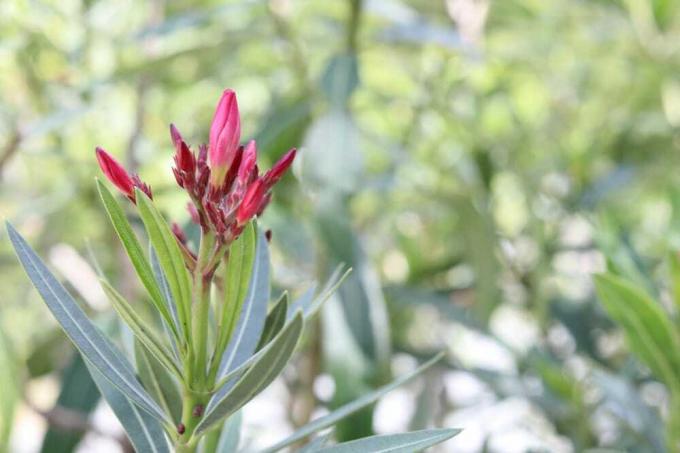
Table of contents
- leaves and flowering time
- propagation
- Pests & Diseases
- Oleander - location & care
- Cut oleanders
- Overwintering oleanders
- Editor's Warning!
The oleander has been cultivated in Central Europe for around 400 years Garden-, and ornamental plant offered whereby this plant originally comes from the Mediterranean area. He is in Germany next to that olive tree, to the orange tree, the hemp palm, the passion flower, to the hibiscus and the angel trumpet one of the most popular pot plants.
leaves and flowering time
Oleander leaves are dark green, between 6 and 10 centimeters long and are arranged in groups of three like a whorl on a branch. The cyme bloom has five sepals and petals each and is from June to September to see. The color of the oleander ranges from white, yellowish to pinkish red and the oldest leaves fall off once they have yellowed. The flowers of the oleander bloom profusely only in summer, while the buds do not unfold in cold temperatures. The oleander is pollinated by long-nosed butterflies, which produces fruit capsules that are up to 15 centimeters long.
propagation
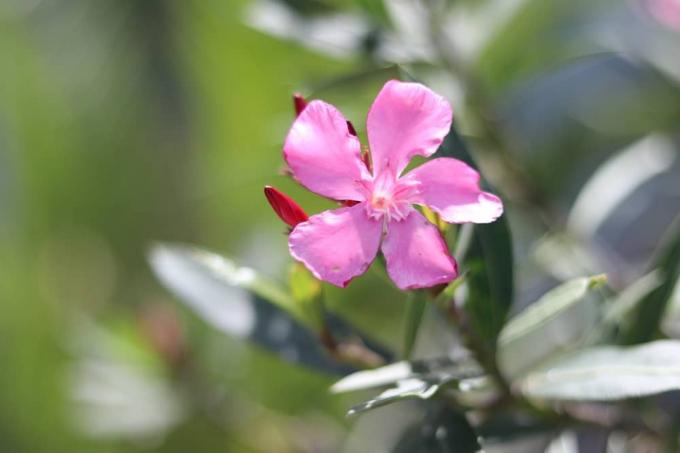
An oleander propagates through cuttings, with the best propagation time being from June to September. For propagation, only strong shoot tips that do not have flowers should be exposed.
- The shoot tips are cut with scissors or a knife.
- The cuttings are placed in a container filled with water and placed in a shady location.
- The lower shoot tip should be a maximum of 5 centimeters under water.
- Rooting usually takes about four weeks. As soon as the roots are 1 to 2 centimeters long, they are potted.
Pests & Diseases
Oleander can from aphids, scale insects, mealybugs and oleander canker. The aphids should only be fought with cold-free plant spray. If there is a small infestation of scale insects, they can be combated with a wet cloth or sponge. If the scale insect infestation is more severe, it should also be combated with an appropriate plant spray, whereby the treatment has to be done every three to five days.
Oleander - location & care
The botanical name of the oleander says it all when it comes to caring for it. The Greek nerium means "damp, wet" and the nickname oleander is derived from the Latin "oleum" for oil. In its original wild form, the oleander occurs in the Mediterranean region on the edges and banks of rivers. This also explains the high water requirement of this plant. Refined as a cultivated plant for about four hundred years, it has meanwhile also become native to the northern regions up to Heligoland. It is particularly popular as a container plant because of its flowers.
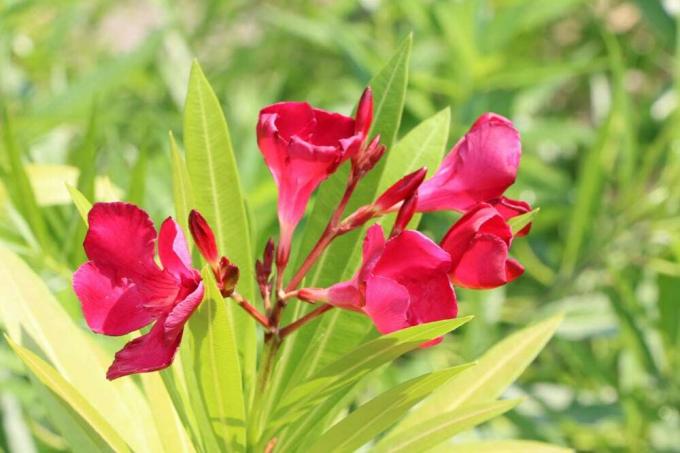
The oleander likes it bright, warm and with plenty of water. Ideally, it should be sheltered from the wind and rain so that it can develop and preserve its full bloom. A parking space on the east side of the house is possible, but not necessarily ideal. The oleander prefers the south and south-west side, because the duration of sunshine and the warmth at the location are the conditions for rich flowering. The plant needs to be watered regularly, avoiding watering with rainwater. Fertilization is also of particular importance, as the oleander has a high nutrient requirement.
- The oleander thrives best in a good mixture of peat dust and potting soil.
- Because oleanders also grow well with lime water, this plant can also be watered with normal tap water - although rainwater is definitely more suitable.
- The best fertilizer is the complete fertilizer, whereby blue grain can also be very helpful, because the oleander is supplied with additional nutrients for a longer period of time and thus thrives better.
Cut oleanders
Pruning is not really necessary with oleander, but older plants should be pruned back. It is best to carry out a thinning cut every one to two years, during which the longest and very old shoots are cut back down to the old wood. The best time for such a cut is the post bloom period or before the first snow falls.
Overwintering oleanders
The preferred temperature of the oleander for wintering is between 0 and 10 degrees Celsius. In general, it is recommended to move the plants to the winter quarters as late as possible, since the climatic conditions and lighting conditions are rarely optimal. Although the oleander can withstand frost down to -5 degrees, there is a risk of frost damage to the plant during longer frost periods or lower temperatures. Depending on the size of the oleander bush, preparations for overwintering in sheltered outdoor areas such as in front of house walls, on terraces or in carports are necessary.
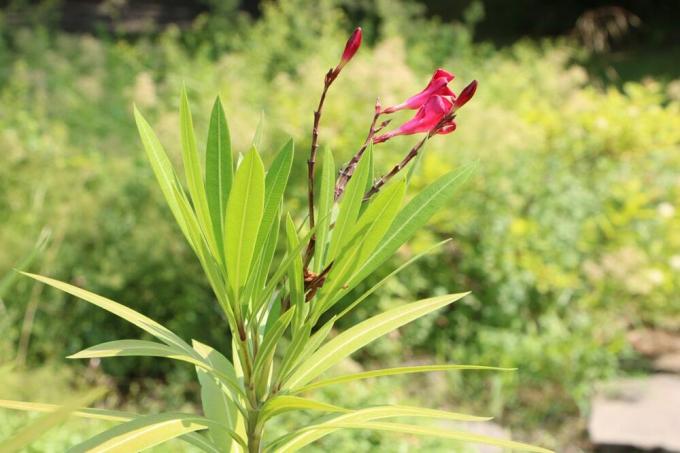
However, oleander is not hardy, so overwintering outdoors comes with risks for the shrub. Alternatives are accommodation in sheltered but unheated rooms such as conservatories, garages, basements or similar. The following applies to hibernation:
- as bright a location as possible with daylight
- Ambient temperature between 0 and 10 degrees Celsius
- if the room for wintering is dark, the ambient temperature must also be low
- only water moderately during the rest phase, avoid waterlogging
- regular inspection for pest infestation
- Cut next spring
- after hibernation, initially put them in a shady place for a few days
When spending the winter outdoors, the following still applies:
- sheltered location (not on the weather side!)
- place a thick styrofoam or insulating board under the planter
- Wrap the planter in jute, bubble wrap or fleece
- additionally pad and insulate the planter with straw or leaves
- tie the upper parts of the plant together and wrap them with protective fleece or cover them with hoods
- in frost-free times free the plant from the protective covers
Editor's Warning!
Due to its extreme toxicity, the juice of an oleander should never be put in the mouth or even in the eyes because it causes headaches, cramps, nausea, cardiac arrest and skin irritation can.
 garden editorial
garden editorial I write about everything that interests me in my garden.
Learn more about potted plants

Abalie, Abelia grandiflora: 14 tips for proper care
The large-flowered abalia (Abelia grandiflora) is an extraordinarily easy-care ornamental shrub that delights with numerous funnel-shaped and subtly scented flowers. It is just as suitable as a background plant as a hedge or container plant.

Caring for the tangerine tree properly | 13 tips for the tangerine tree
Many citrus plants have evolved from the tangerine, one of the oldest and most original citrus species. With its white flowers and orange fruits, it is a feast for the eyes and the palate. In this country it is only cultivated as a container plant due to its sensitivity to frost.

Indian canna, Canna indica | 13 tips for care
Canna indica, also known by the botanical name Canna indica, is a decorative plant that not only enriches every garden during flowering. In pot culture, it can be used as an accent for many years thanks to its color and growth.

11 absolutely hardy container plants
Absolutely hardy potted plants have several advantages to offer, because they can remain outdoors even when the temperature is below zero and require little protection. If they are also evergreen, they can also bring joy all year round.

Is dwarf bamboo hardy? | 11 tips for care & cutting
Dwarf bamboo is one of the easy-care sweet grasses. In the garden, it can be used as a good ground cover, as it does not grow as tall as its larger relatives. Whether the plant is hardy and how it is cared for and cut can be read in the guide.
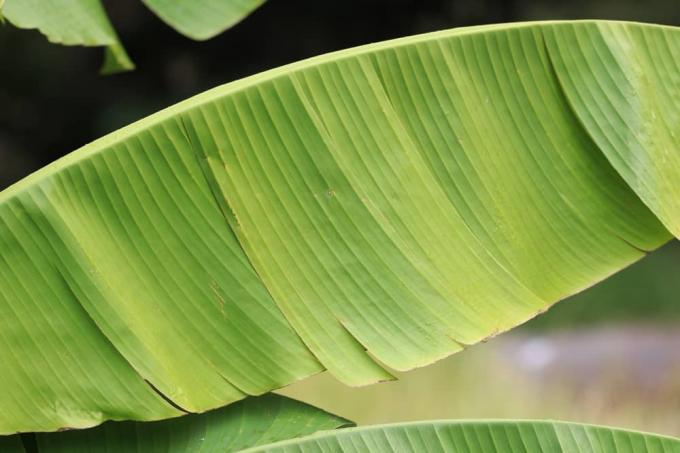
Pink dwarf banana, Musa velutina | Care of the Kenya Banana
The pink dwarf banana (Musa velutina) is an eye-catcher in the garden. It grows to a maximum of two meters and impresses with its impressive flowers. The small pink fruits taste sweet and aromatic. If you want to harvest the exotic fruits, you should follow our care tips.



